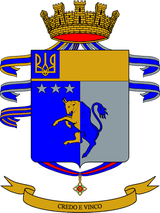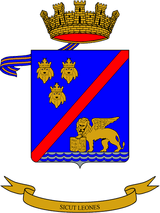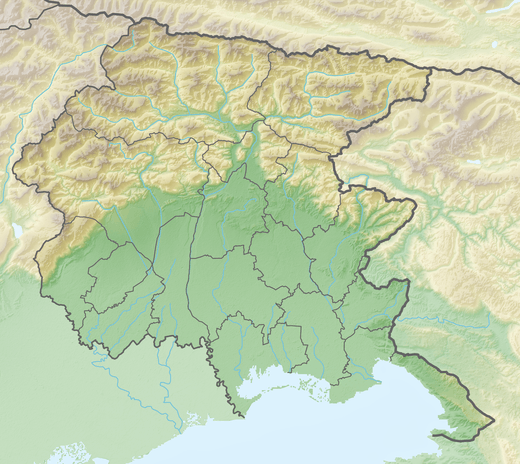Mechanized Brigade "Gorizia"
The Mechanized Brigade "Gorizia" was a mechanized brigade of the Italian Army. Its core units were mechanized infantry battalions. The brigade's headquarters was in the city of Gorizia and the brigade's units were based in the region of Friuli-Venezia Giulia. The brigade's name was chosen in memory of the World War I Battle of Gorizia. The brigade's sister brigade the Armored Brigade "Vittorio Veneto" was named to commemorate the World War I Battle of Vittorio Veneto.
| Brigata Meccanizzata "Gorizia" | |
|---|---|
 Coat of Arms of the Mechanized Brigade "Gorizia" | |
| Active | 20 October 1975 - 30 October 1996 |
| Country | Italy |
| Branch | Italian Army |
| Type | Infantry |
| Role | Armored warfare |
| Part of | 1975-1986 Mechanized Division "Folgore" 1986-1996 5th Army Corps |
| Garrison/HQ | Gorizia |
Founded in, based in, and named after the city of Gorizia the brigade's coat of arms was based on the coat of arms of the medieval House of Gorizia.
History
In 1975 the Italian Army undertook a major reorganization of its forces: the regimental level was abolished and battalions came under direct command of multi-arms brigades. As tensions with Yugoslavia over the city if Trieste were allayed by the Treaty of Osimo and because a reduction of the military service from 15 to 12 months for the army and air force and from 24 to 18 months for the navy, forced the army to reduce its forces by nearly 45,000 troops, it was decided that the units of the Infantry Division "Folgore" would contract to brigade. Therefore after disbanding most units of the division, the remaining units were used to raise the Mechanized Brigade "Gorizia" in Gorizia on 20 October 1975. The brigade's command was created by reorganizing and renaming the command of the 82nd Infantry Regiment "Torino" in Gorizia. After the activation the "Gorizia" brigade entered the Mechanized Division "Folgore", which was part of the 5th Army Corps based in North-Eastern Italy. The 5th Army Corps was tasked with defending the Yugoslav-Italian border against possible attacks by either the Warsaw Pact, or Yugoslavia or both. The Gorizia was to defend the city of Gorizia and the brigade's two infantry fortification battalions were tasked to man and hold the fixed positions of the Alpine Wall. The brigades strength was around 5,000 men and it was composed by the following units:

- Command and Signal Unit "Gorizia", in Gorizia








- Anti-tank Company "Gorizia", in Gorizia (BGM-71 TOW anti-tank guided missiles)
- Engineer Company "Gorizia", in Cormons
On 31 October 1986 the Italian Army abolished the divisional level and brigades, that until then had been under one of the Army's four divisions, came forthwith under direct command of the Army's 3rd or 5th Army Corps. Thus the Gorizia came under direct command of the 5th Army Corps. From the disbanded "Folgore" Division the Gorizia received the 53rd Infantry Fortification Battalion "Umbria", in Pavia di Udine and at the same time ceded the 33rd Infantry Fortification Battalion "Ardenza" to the Mechanized Brigade "Vittorio Veneto".
After the end of the Cold War the Italian Army began to draw down its forces: first the 63rd Infantry Fortification Battalion "Cagliari" was disbanded on 30 November 1991, followed by the 53rd Infantry Fortification Battalion "Umbria" on 31 March 1993, while the 183rd Mechanized Infantry Battalion "Nembo" was transferred to the Paratroopers Brigade "Folgore" in 1991. During the same year the 184th Self-propelled Field Artillery Group "Filottrano" joined the brigade.[8] At the same time for traditional reasons the battalions were renamed as regiments without changing composition or strength. For the last year of its life the brigades was composed by the following units:

- Command and Tactical Supports Unit "Gorizia", in Gorizia





On 30 September 1995 the 41st Infantry Regiment was disbanded. On 30 October 1996 the brigade was disbanded with the rest of its units.[8] Only the 82nd Infantry Regiment remained and passed to the Mechanized Brigade "Mantova".
External links
- "82° Reggimento Fanteria "Torino" - La Storia". Esercito Italiano. Retrieved 17 November 2018.
- F. dell'Uomo, R. Puletti (1998). L'Esercito Italiano verso il 2000 - Vol. Primo - Tomo I. Rome: SME - Ufficio Storico. p. 70.
- F. dell'Uomo, R. Puletti (1998). L'Esercito Italiano verso il 2000 - Vol. Primo - Tomo I. Rome: SME - Ufficio Storico. p. 211.
- Stefani, Filippo (1989). La storia della dottrina e degli ordinamenti dell'Esercito Italiano - Vol. III - Tomo 2nd. Rome: Ufficio Storico - Stato Maggiore dell'Esercito. pp. 1181–1182.
- F. dell'Uomo, R. di Rosa (2001). L'Esercito Italiano verso il 2000 - Vol. Secondo - Tomo I. Rome: SME - Ufficio Storico. p. 213.
- "Reggimento Lagunari "Serenissima" - La Storia". Esercito Italiano. Retrieved 15 November 2018.
- "183° Reggimento Paracadutisti "Nembo" - La Storia". Esercito Italiano. Retrieved 17 November 2018.
- "184° Reggimento Artiglieria Paracadutisti "Nembo"". Italian Army. Retrieved 22 November 2019.
